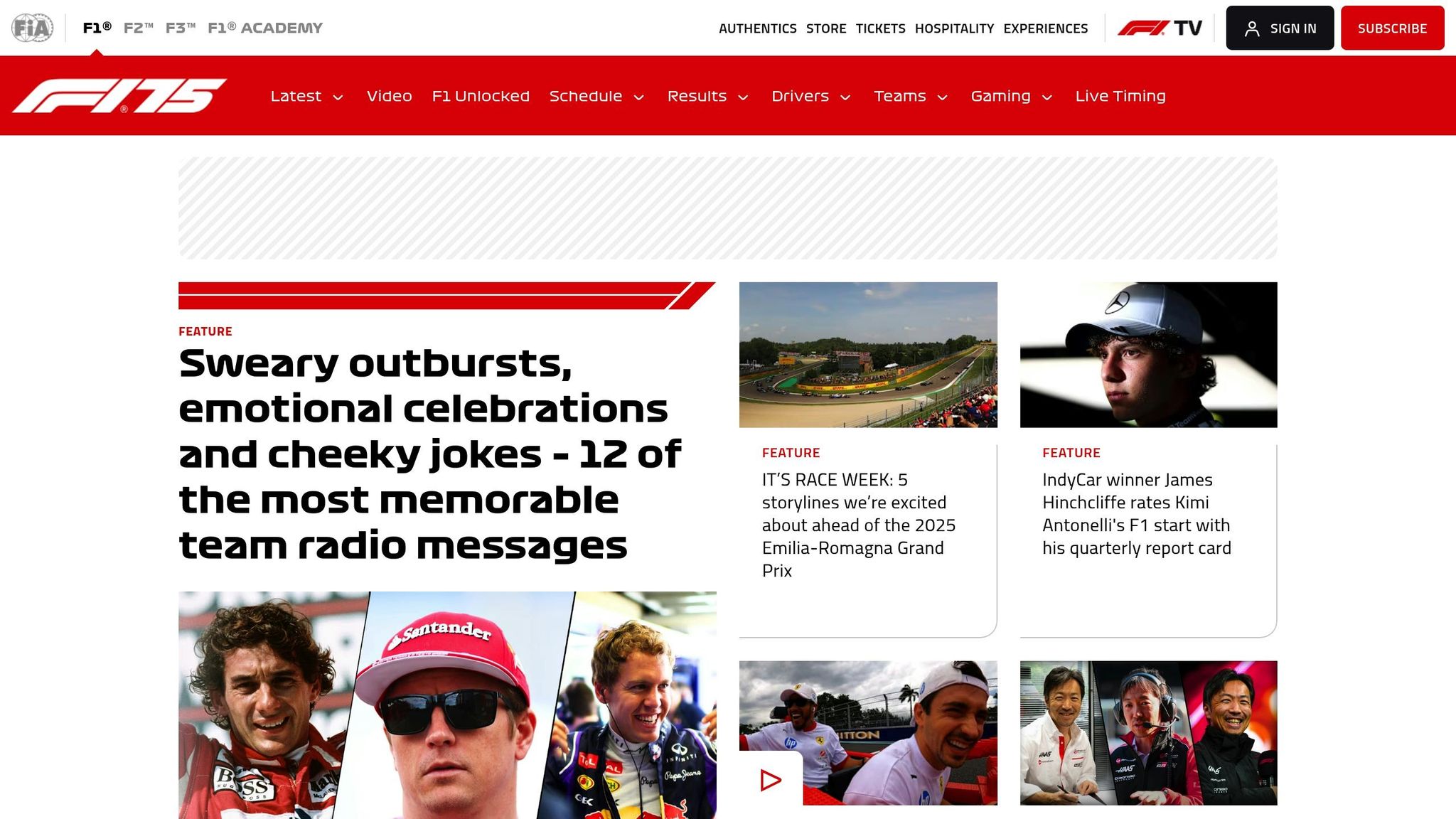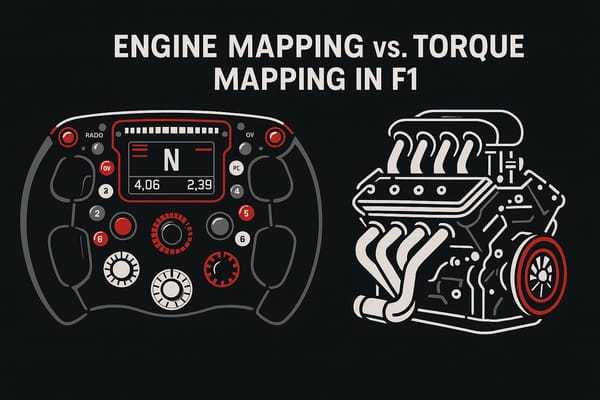F1 Engine Maps: Role in Calibration
Explore how F1 engine maps enhance power delivery, fuel efficiency, and hybrid system management, shaping the future of motorsport.

F1 engine maps are the backbone of modern Formula One power units, translating a driver's pedal inputs into precise engine behavior. These digital blueprints control critical aspects like throttle response, fuel injection, ignition timing, and hybrid energy deployment. Here's what you need to know:
- What They Do: Engine maps manage power delivery, balance fuel efficiency, and optimize hybrid systems for performance.
- Key Features:
- Internal Combustion Engine (ICE): Controls fuel injection, ignition timing, and air intake.
- Energy Recovery Systems (ERS): Manages MGU-K and MGU-H for energy deployment and recovery.
- Turbocharger: Adjusts boost pressure and waste gate for efficiency.
- Applications:
- Track-specific tuning for elevation, weather, and layout.
- Qualifying vs. race modes for maximum power or endurance.
- Real-time adjustments for fuel conservation and race tactics.
- Regulations: FIA mandates a standardized control unit (SECU) to ensure fairness, limiting customization to calibration parameters only.
Engine maps are constantly refined using telemetry, track data, and testing to balance power, efficiency, and compliance with FIA rules. With AI and biofuel advancements on the horizon, this technology is shaping the future of F1 performance and sustainability.
Engine Map Fundamentals
Engine Map Definition
Engine maps are essentially digital blueprints that dictate how Formula One power units respond to the driver's inputs. These maps manage crucial aspects like fuel delivery, ignition timing, and torque output, all tailored to the engine's operating conditions.
Building on the concept of input conversion, engine maps refine signals from the accelerator through tools like the Driver Pedal and Torque Demand Maps. These systems rely on sensor data to translate pedal pressure into precise torque output.
With this groundwork in place, let’s dive into the specific elements that make precise power unit calibration possible.
Key Engine Map Components
Modern Formula One power units depend on three major systems, all of which are tightly controlled by engine maps:
-
Internal Combustion Engine (ICE)
Engine maps regulate:- Fuel injection timing and quantity
- Ignition timing and throttle control
- Air intake adjustments
-
Energy Recovery Systems (ERS)
These systems include:- Coordination of the Motor Generator Unit – Kinetic (MGU-K)
- Management of the Motor Generator Unit – Heat (MGU-H)
- Execution of energy deployment strategies
-
Turbocharger Management
Tasks here involve:- Controlling boost pressure and the waste gate
- Overseeing energy recovery by the MGU-H
One of the most critical calibrations within the SECU is the torque map. It not only synchronizes these systems but also ensures smooth engine responses during rapid input changes. For example, during engine overrun - when the driver lifts off the throttle - the maps can switch between firing just four cylinders or cutting ignition entirely. This adjustment optimizes engine braking performance.
These parameters are fine-tuned to match race conditions and strategies. Teams achieve this through rigorous testing on dynamometers, followed by further refinements during track sessions, ensuring the engine delivers peak performance across all scenarios.
Engine Maps in Power Unit Calibration
Track-Specific Adjustments
Formula 1 teams tailor engine maps for each circuit by accounting for factors like elevation, temperature, and track design. For example, high-altitude venues like Mexico City's Autódromo Hermanos Rodríguez demand specific adjustments to handle thinner air, ensuring the turbocharger performs efficiently.
Typically, teams start with baseline maps that are further refined using real-time track data. This process allows engineers to adjust key parameters such as:
- Circuit Layout: Tweaking power delivery for high-speed straights versus tight, technical corners.
- Altitude Effects: Modifying turbo boost and fuel-air mixture to adapt to changes in air pressure.
- Weather Impact: Adjusting for shifts in temperature and humidity to maintain performance.
These refinements aim to strike a balance between raw power output and operational efficiency.
Power and Fuel Balance
Once circuit-specific tweaks are in place, teams focus on fine-tuning engine maps to balance outright power with fuel economy. Since the FIA imposes strict fuel flow limits, engine maps help manage throttle response and fuel delivery across different phases of a race.
Using telemetry data gathered during practice sessions, teams refine strategies to optimize fuel usage. Key areas of focus include:
- Timing and quantity of fuel injection.
- Shaping throttle response curves for various track sections.
- Adjusting engine braking to improve energy recovery and reduce fuel consumption.
This balancing act ensures teams can maximize performance without exceeding fuel limits.
Hybrid System Control
Modern F1 power units rely heavily on engine maps to synchronize the internal combustion engine with hybrid systems. These maps ensure seamless power delivery from both the engine and the energy recovery systems, focusing on:
| System Component | Mapping Function | Performance Impact |
|---|---|---|
| MGU-K | Timing of energy deployment | Boosts acceleration and top-end speed. |
| MGU-H | Turbocharger efficiency | Reduces turbo lag and enhances recovery. |
| Power Integration | Coordination of combined output | Ensures smooth, consistent power delivery. |
Throughout the race weekend, engineers refine these mappings using data from practice and qualifying sessions. The goal is to optimize hybrid deployment, recover as much energy as possible, and maintain a steady power output during the race.
Engine Map Applications
Qualifying vs Race Settings
In Formula 1, teams utilize distinct engine maps for qualifying and race sessions, tailoring the car's performance to the specific demands of each. Qualifying maps are all about squeezing out maximum power for short bursts, prioritizing speed over durability.
| Parameter | Qualifying Map | Race Map |
|---|---|---|
| Power Output | Maximum available power | Balanced for endurance |
| Fuel Consumption | High consumption | Efficient |
| Engine Stress | High – short-term performance | Moderate – long-term reliability |
| ERS Deployment | Aggressive, full deployment | Strategic deployment patterns |
While qualifying maps push the engine to its limits, race maps strike a balance between performance and reliability, ensuring the car can endure the entire race distance. Fuel management becomes especially crucial during race conditions.
Fuel Conservation Methods
Engine mapping plays a key role in managing fuel consumption without sacrificing competitive lap times. By fine-tuning various engine parameters, teams can maintain a strong pace while conserving fuel. Key adjustments include:
- Throttle Response: Regulates how engine power is delivered based on pedal input.
- Fuel Injection Timing: Controls when fuel enters the combustion chamber for optimal efficiency.
- Ignition Timing: Determines the precise moment the fuel-air mixture ignites.
These adjustments are constantly monitored and fine-tuned by the engine management system, which ensures fuel consumption aligns with performance goals and regulatory limits.
Race Position Tactics
Beyond fuel efficiency, engine mapping is also a tactical tool that can adapt to changing race scenarios. Teams can switch between mapping configurations in real time to gain an edge, whether attacking or defending on the track.
Offensive mapping focuses on:
- Boosting power for straight-line speed.
- Refining torque curves for quicker acceleration.
- Strategically deploying stored electrical energy for overtaking.
Defensive mapping, on the other hand, prioritizes:
- Balanced power output to protect engine components.
- Adjusted throttle response for better control in tight situations.
- Conservative energy recovery to maintain consistent performance.
The torque map is central to these strategies, influencing aspects like pit lane speed limits and gear shift points. Combined with real-time telemetry, teams can make rapid adjustments to their engine maps, ensuring they stay competitive as race conditions evolve.
Rules and Technical Limits
FIA Engine Map Rules

Engine mapping in motorsport is tightly regulated to maintain fairness and consistency. The Fédération Internationale de l'Automobile (FIA) enforces these rules by requiring all teams to use a standardized Standard Electronic Control Unit (SECU). This approach ensures a level playing field by restricting how much teams can customize engine maps.
Here are some key requirements teams must follow:
- Only the calibration parameters within the fixed SECU software can be adjusted.
- All engine maps must be thoroughly documented and available for FIA inspection.
- Torque maps must deliver predictable performance that complies with the rules.
| Parameter | Regulatory Requirements | Compliance Measures |
|---|---|---|
| SECU Software | Base code must remain unchanged | Audited regularly by FIA |
| Calibration | Adjustments limited to mapping parameters | Full documentation required |
| Power Output | Must stay within specified limits | Verified through sensors |
These rules are designed to prevent teams from gaining an unfair advantage through software manipulation.
Rule Violations
Past breaches highlight the importance of these regulations. For example, in 2012, some teams exploited engine maps to maintain exhaust gas flow over diffusers, even when drivers were off-throttle. This gave them an aerodynamic advantage, prompting the FIA to tighten its control over SECU software modifications.
"The FIA required that the SECU software remain unchanged and only allowed calibration (mapping) to adapt to each engine and car, effectively closing this loophole", noted Nextgen-Auto in March 2012.
To enforce compliance, the FIA employs a range of monitoring and inspection methods, including:
- Real-time tracking of engine data during races.
- Routine checks of team-submitted documentation.
- Standardized testing to ensure adherence to regulations.
- Issuing updated technical directives in response to emerging strategies.
Penalties for breaking these rules are severe, ranging from disqualification in individual races to the loss of championship points. These measures are critical in ensuring that any performance gains come from genuine engineering advancements rather than exploiting software gaps.
As teams continue to innovate, the FIA adapts its regulatory framework to address new challenges, ensuring the sport remains competitive and fair.
Next-Generation Engine Maps
AI in Engine Mapping
Next-generation engine mapping technology is advancing at breakneck speed, thanks to the integration of AI and machine learning. Formula 1 teams are now leveraging supervised learning models trained on mountains of historical race data to fine-tune engine performance in real time. These systems digest a wealth of information - engine telemetry, track conditions, weather, tire wear, and fuel consumption - to make rapid adjustments to engine parameters. For example, teams like Mercedes and Red Bull have developed their own AI systems to optimize hybrid energy deployment and fuel mixture settings. This technology proves especially useful in unpredictable weather, where recalibrating engine settings quickly can make all the difference.
Biofuel Impact
At the same time, the shift toward sustainable fuels is forcing teams to rethink how they calibrate engine maps. Biofuel blends introduce unique combustion challenges, requiring adjustments to ignition timing, fuel injection, and knock protection. Teams are heavily investing in dyno testing and advanced simulations to ensure their engine maps can handle these new fuel properties without sacrificing performance.
FIA regulations, which impose strict rules on software complexity, data transmission, and fuel composition, will shape how quickly these technologies can be adopted. However, the combination of AI-driven optimization and biofuel adaptation is expected to redefine engine mapping. These developments are not just about shaving seconds off lap times - they could also pave the way for innovations that influence the cars we drive every day.
F1 engine mapping - Chain Bear explains

Conclusion
Engine maps play a crucial role in fine-tuning F1 power units, going far beyond simple power delivery. They influence fuel efficiency, manage hybrid systems, and ensure compliance with FIA regulations.
Over the years, the technology behind engine mapping has made impressive strides, allowing teams to adapt power delivery to different racing scenarios. For example, aggressive qualifying maps often make the difference in securing pole positions, while more conservative race maps help balance speed and reliability. These advancements are shaping the future of performance calibration in the sport.
Through the Powertrain Control Unit (PCU), teams manage critical aspects like throttle response, fuel injection timing, and hybrid energy deployment. Constant refinement of these systems is key to unlocking every ounce of performance.
With the rise of AI-driven solutions and the push for biofuel integration, engine mapping is entering a new era. These innovations are not only revolutionizing Formula One but are also influencing automotive technology on a global scale.
As F1 continues to evolve, engine mapping will remain at the forefront, balancing the pursuit of peak performance with regulatory and environmental challenges. This technology will undoubtedly continue to set teams apart in the highly competitive world of Formula One.
FAQs
How do F1 teams use engine maps to optimize performance for different track conditions like altitude and weather?
F1 teams rely on engine maps to fine-tune their power units for different track conditions, accounting for factors like altitude, temperature, and weather. These maps are essentially software configurations that manage how the engine delivers power, ensuring it performs efficiently no matter the environment.
Take high-altitude circuits, like Mexico City, for instance. The thinner air at these tracks reduces air density, which can affect engine performance. To counter this, teams adjust the engine map to optimize the turbocharger, ensuring the car maintains power. In wet or cold conditions, the engine map is tweaked to deliver power more smoothly, helping drivers keep control on slippery surfaces. By adapting the engine’s behavior to the track and weather, teams strike a balance between performance and reliability throughout the race.
How do engine maps help optimize power and fuel efficiency in Formula 1 races?
Engine maps play a key role in Formula 1, helping teams manage the performance of a car's power unit. These maps let engineers tweak the engine's settings to strike the perfect balance between delivering maximum power and saving fuel, depending on what the race demands.
Drivers can switch between various engine maps during a race to handle different situations, like overtaking, conserving fuel, or reducing tire wear. By adjusting factors such as fuel injection, ignition timing, and turbo pressure, these maps ensure the car runs at its best while staying within regulations and maintaining reliability.
How might AI and biofuels shape the future of F1 engine mapping?
The Role of AI and Biofuels in Shaping Formula One Engine Mapping

The future of Formula One engine mapping is set to be transformed by AI advancements and the integration of biofuels. AI brings the ability to analyze real-time data during races, helping teams fine-tune engine performance on the fly. This means better decisions about fuel efficiency, power output, and reliability - crucial factors in a sport where every millisecond counts.
At the same time, the move toward sustainable biofuels introduces new challenges. These fuels come with unique combustion properties, requiring engines to be recalibrated to adapt effectively. Together, AI and biofuels could change the way F1 power units are managed, combining peak performance with a stronger focus on environmental responsibility.




